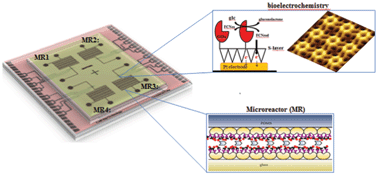In the current work we have developed a lab-on-a-chip containing embedded amperometric sensors in four microreactors that can be addressed individually and that are coated with crystalline surface protein monolayers to provide a continuous, stable, reliable and accurate detection of blood glucose. It is envisioned that the microfluidic device will be used in a feedback loop mechanism to assess natural variations in blood glucose levels during hemodialysis to allow the individual adjustment of glucose. Reliable and accurate detection of blood glucose is accomplished by simultaneously performing (a) blood glucose measurements, (b) autocalibration routines, (c) mediator-interferences detection, and (d) background subtractions. The electrochemical detection of blood glucose variations in the absence of electrode fouling events is performed by integrating crystalline surface layer proteins (S-layer) that function as an efficient antifouling coating, a highly-oriented immobilization matrix for biomolecules and an effective molecular sieve with pore sizes of 4 to 5 nm. We demonstrate that the S-layer protein SbpA (from Lysinibacillus sphaericus CCM 2177) readily forms monomolecular lattice structures at the various microchip surfaces (e.g. glass, PDMS, platinum and gold) within 60 min, eliminating unspecific adsorption events in the presence of human serum albumin, human plasma and freshly-drawn blood samples. The highly isoporous SbpA-coating allows undisturbed diffusion of the mediator between the electrode surface, thus enabling bioelectrochemical measurements of glucose concentrations between 500 μM to 50 mM (calibration slope δI/δc of 8.7 nA mM−1). Final proof-of-concept implementing the four microfluidic microreactor design is demonstrated using freshly drawn blood. Accurate and drift-free assessment of blood glucose concentrations (6. 4 mM) is accomplished over 130 min at 37 °C using immobilized enzyme glucose oxidase by calculating the difference between autocalibration (10 mM glc) and background measurements. The novel combination of biologically-derived nanostructured surfaces with microchip technology constitutes a powerful new tool for multiplexed analysis of complex samples.

You have access to this article
 Please wait while we load your content...
Something went wrong. Try again?
Please wait while we load your content...
Something went wrong. Try again?


 Please wait while we load your content...
Please wait while we load your content...